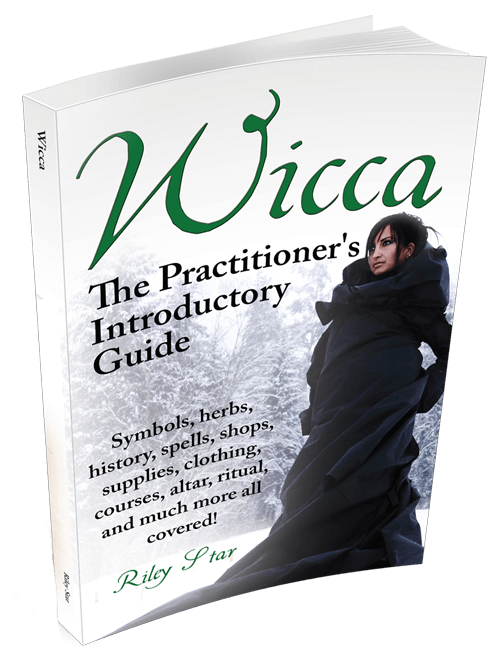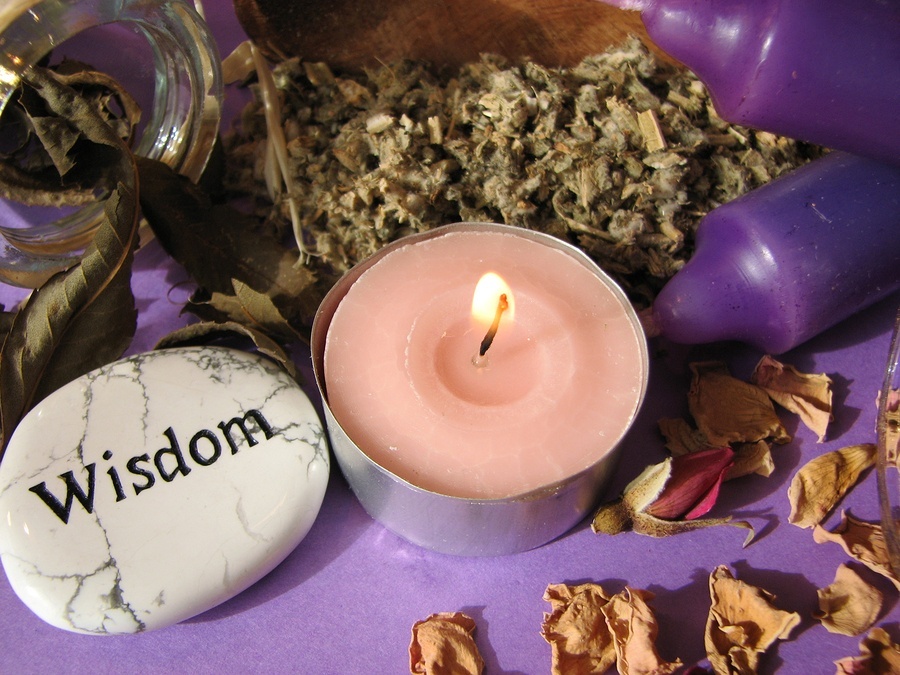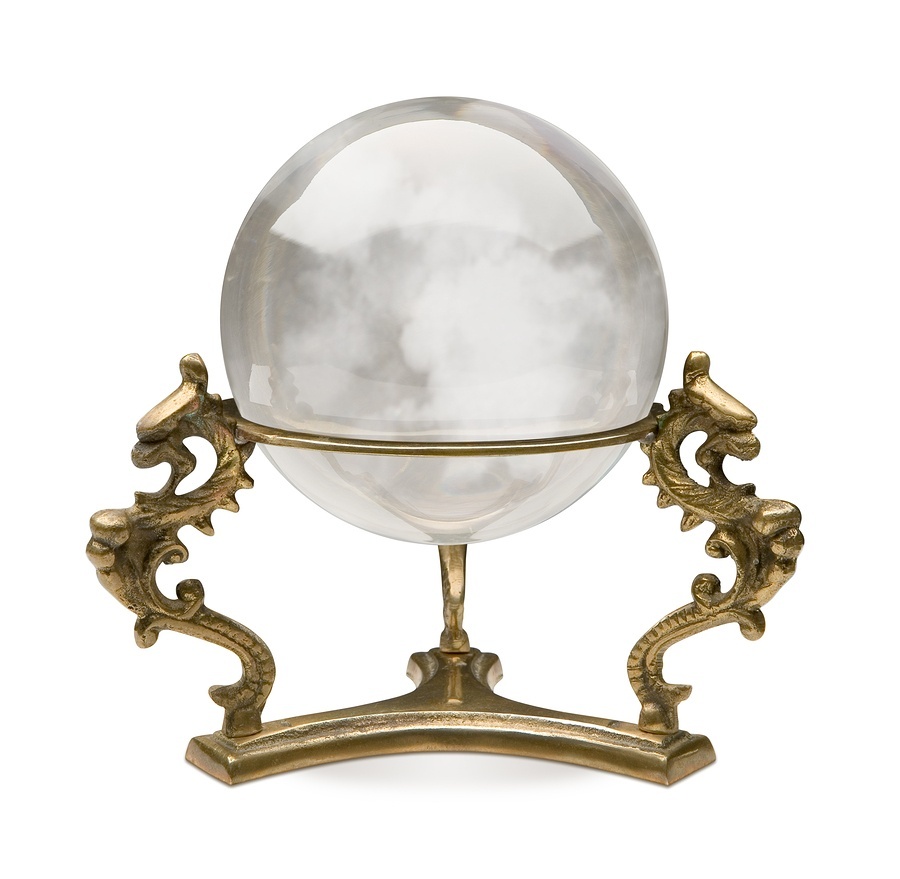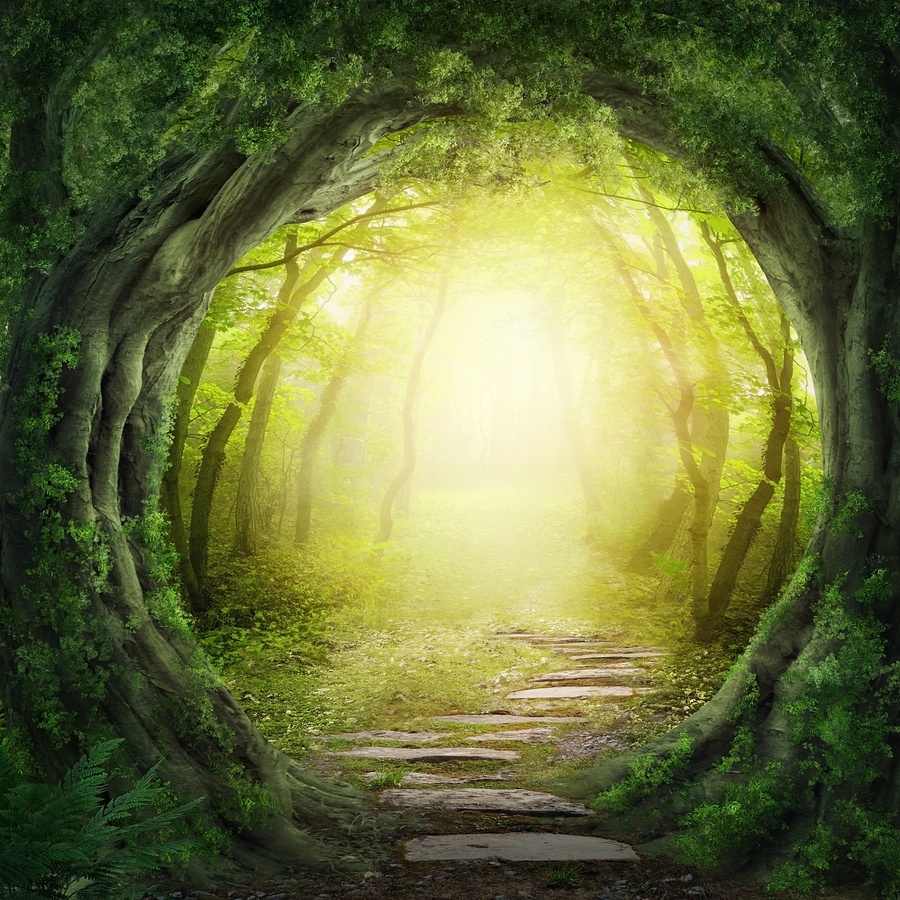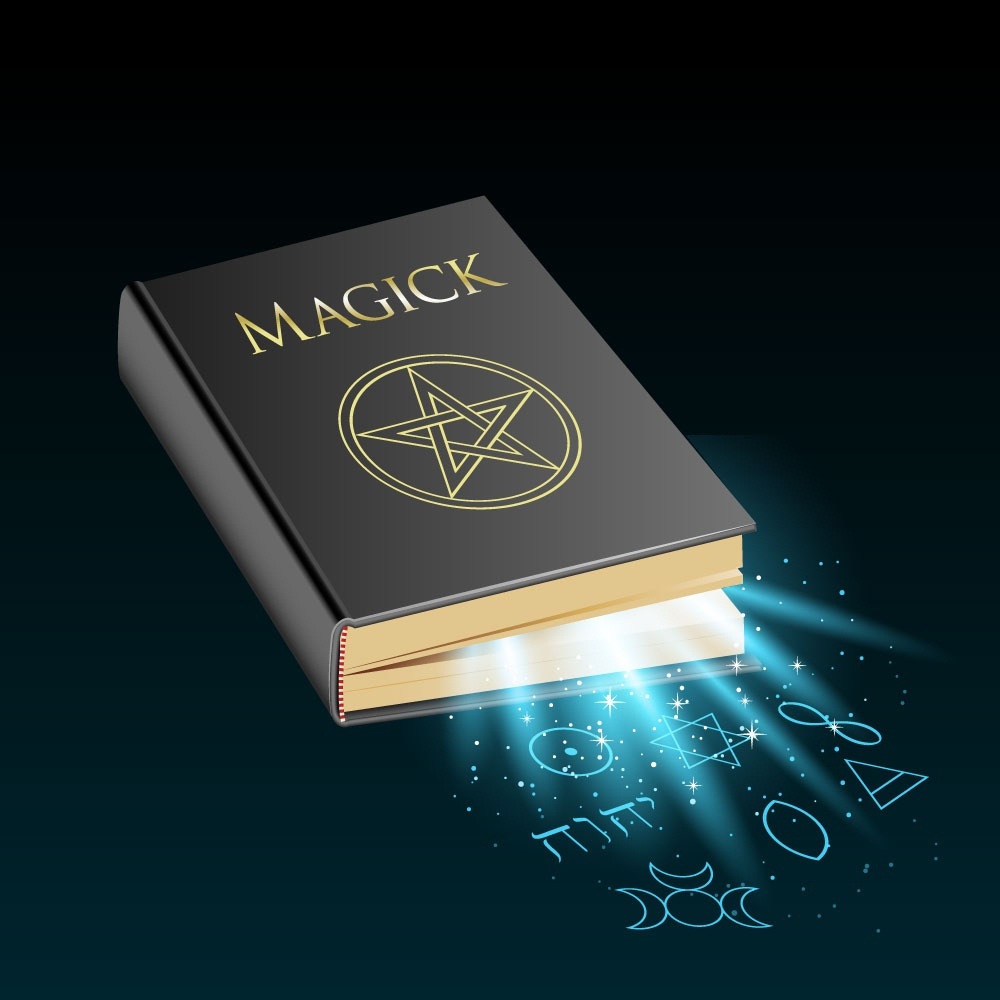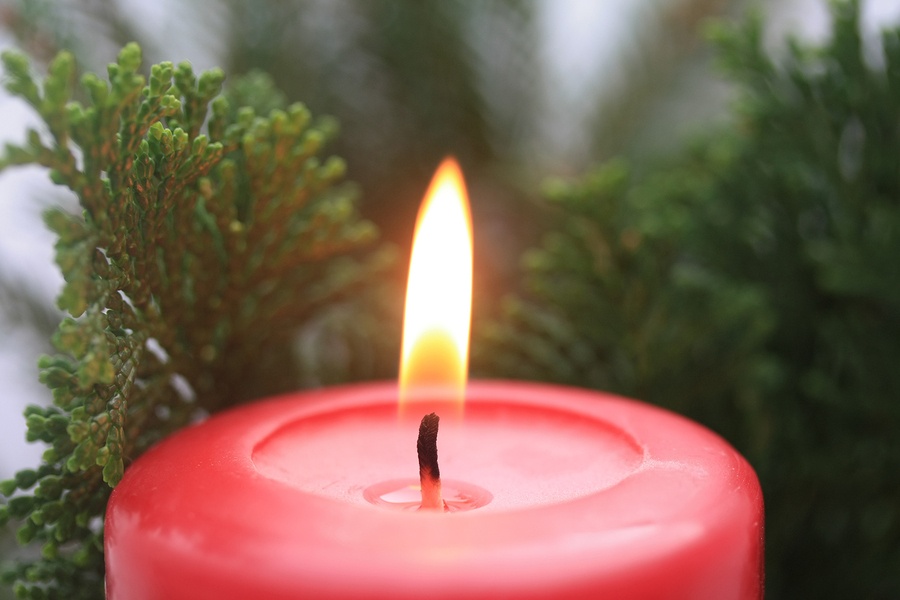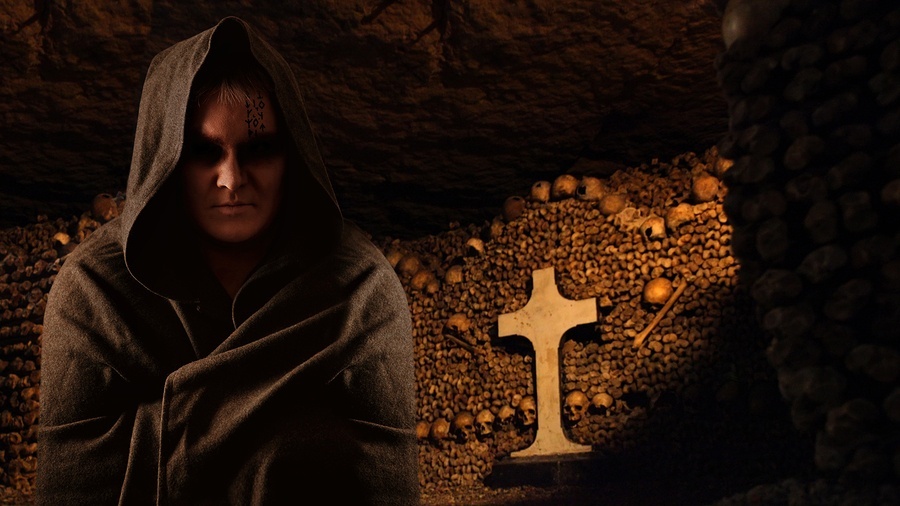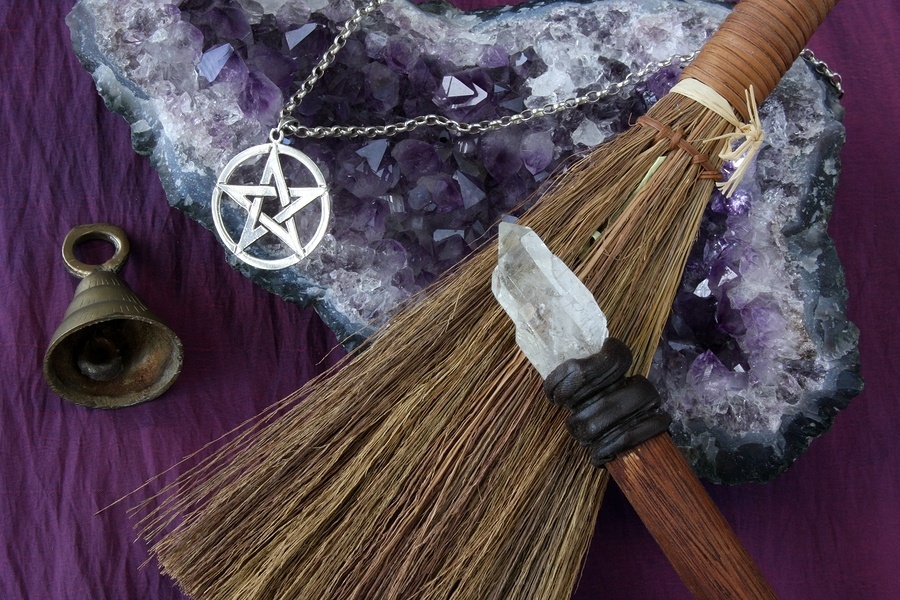Chapters
Navigate to chapter
► Chapter 1: Introduction to Wicca
► Chapter 2: The History of Wicca and Witchcraft
► Chapter 3: Modern Wicca
► Chapter 4: The Wiccan Deities
► Chapter 5: Deciding to Become a Witch
► Chapter 6: The Magickal Cabinet
► Chapter 7: Herbs and Crystals
► Chapter 8: Understanding Ritual
► Chapter 9: Wiccan Terminology
Chapter 1: Introduction To Wicca
The problem is no longer one of not being able to find information about Wicca. Now it’s an issue of being able to distinguish good, accurate information from all of the pop culture nonsense littering television, the Internet, and bookstore shelves.
If you go to Google and search just for the word “Wicca” you’ll get 3,850,000 hits, most of which will have very little to do with the real religion of Wicca.
Thanks to television programs like Buffy the Vampire Slayer, Charmed, and Witches of Eastwick, the image most people have of what it means to be Wiccan is to work spells and either (a) spend all your time fending off evil or (b) spend all your time doing evil things. Neither one is Wicca!
What is Wicca?
Wicca is a living religion in a constant state of evolution because it is an experiential way of being in the world. The way Wicca works for any single practitioner is based largely on that person’s life experiences, making this old nature religion deeply personal and ever new.
Although influenced by surviving traditions and based, at least loosely, on a heritage of pagan rites rooted in the shamanistic and Druidic cultures of Western Europe, Wicca is largely what the individual makes of it.
There is co central Church of Wicca, no Wiccan “Bible,” and no specific outline of rules and teaching governing the body of belief. Many Wiccans do keep a “book of shadows,” which is a personal record of their specific spells and rituals, but this is more like a journal than a book dictating beliefs and rules of behavior.
Wiccans may be members of covens who have undergone an initiation and made a formal and ritual declaration of their intent to follow the Wiccan path, or they may be sole practitioners who have made a highly personal and private decision to dedicate themselves to Wicca. Both ways of coming to Wicca are equally valid.
Present Focused and Experiential
Thanks in part to a belief structure free of dogma, but also as an aspect of their view of nature as infused with deity, Wiccans focus on the here and now. They are interested in being a part of the circle of life, and, although they do believe in reincarnation, as we will discuss shortly, there is no notion of going to a “heaven” that is somewhere else.
There is no emphasis, per se, on what happens at death because death, like all the major events of life is a thing to revere. The physical world to the Wiccan is built up of many realities, some denser and heavier, while others are lighter and more spiritual. None, however are seen as the purest or best expression of being.
Wicca is learned by being lived. The individual relies on his or her own senses and experience to tell them what is true, what works within the context of their beliefs, and actually, the substance of those beliefs. But, unlike more doctrinaire faiths, Wiccans are completely comfortable adjusting those beliefs in accordance with the truth of their experiences.
Experience equals integration in the mind of the Wiccan. To have an experience is to “own” it, so that the living of the event becomes a part who you are in a way that cannot be gained from just reading or talking about the thing. Simply put, to follow Wicca, you must experience being Wiccan.
Deeply In Tune with Nature
Not surprisingly, Wiccans deeply revere nature and observe the cycle of the seasons as they play out over the eight major “sabots” or Wiccan holidays:
- Samhain(October 31) – Alternate names for Samhain include Halloween, Last Harvest, Ancestor Night, Feast of the Dead. This is a day to pay tribute to deceased relatives or “ancestors” because it is a time when the border is lifted between worlds
- Midwinter(around December 23) – Also known as Yule, or Winter Rite, Midwinter corresponds with the shortest day of the year, the Winter Solstice. The day symbolizes the rebirth of the God
- Candelmas(February 1) – Candelmas (known alternately as Imbolc, Oimelc, Brigit, and Brigid), this is a celebration of the coming of spring and the renewal of nature. This is the time Wiccans review the achievements of the past year and make resolutions about goals for the coming year.
- Ostara(March 21 or the Spring Equinox) – Also known as Lady Day, the Vernal Equinox, or the Festival of Trees, Ostara is timed with the Spring Equinox when the day and night are of equal length. The rolling of eggs and egg fights are central to the celebration since the egg symbolizes both fertility and rebirth. Offerings of milk and food may be left out for dwarves and fairies, and it is possible to reach the ancestors at this time by gazing into bowls of clear spring water.
- Beltaine(May 1) – Also called May Day, Beltaine merges both Gaelic and Germanic traditions and marks the high point of fertility in the natural cycle. This is a day of love, and has historically been a time for the arrangement of engagements and marriages.
- Midsummer(June 21) – Known by the names Mother Night, Litha, and Samradh as well as Midsommer, this day corresponds with the summer solstice, which is the longest day and shortest night of the year. The wheel begins to turn again toward the coming dark of winter.
- August Eve(August 1 or 2) – This sabbat can be called Lughnasadh, Lammas, the Bread Harvest, or the First Harvest. It is intended to thank the Earth for her harvest and is another good day for marriages as well as for initiations into Wiccan covens.
- Harvest Home(September 21) – Also called the Autumnal Equinox, the Second Harvest, Mabon, or Foghar, this is the official start of fall, and is another time when day and night are of equal length. It is a quiet and peaceful observation spend with family and friends as a ritual of Thanksgiving.
Because Wiccans believe they are an active part of this turning wheel of nature, all the major experiences of life are celebrated including birth, love, sex, and death.
The cathedral of the Wiccan is the flowering meadow, the shady forest, the sandy beach, or the majestic desert. All are sanctified by the presence of deity and in such places, the earth is constantly speaking to us.
It is no wonder that Wiccans often hold their rituals outdoors, tapping into the mystery tradition of spiritual experiences too deep to be described in words.
As Thea Sabin writes in, Wicca for Beginners: Fundamentals of Philosophy and Practice, “Mystery religions are those that create a setting or a venue where people can have an immediate experience of the reality of the divine.
These paths teach that there are things that are beyond the reach of our five senses, but are nevertheless integral parts of us that we can touch directly, although the method will be different for each of us.”
From the perspective of the world as their cathedral, Wiccans seek to walk lightly on mother earth. Not surprisingly, many Wiccans are vegetarians or vegans and most are committed to environmental causes.
Aware of Magic
To be Wiccan is to be part of a magical system. Performing magic may be as mundane as using a small spell to help you find your lost keys, or a more elaborate expression of personal magic to focus your power and commune with the deity.
As Sabin describes it in Wicca for Beginners, “In essence, [magic is] working your will to find your purpose in life and to align with your higher self.”
As a religion, however, Wicca is not exclusively about performing magic, and magic exists completely apart from the religion. There are many Wiccans who do not perform any magic at all, and it is a mistake to think that the words “Wicca” and “witch” are interchangeable.
It is more accurate to say that both Wiccans and witches who do not self-identify as Wiccans are all pagans, and all pagans are practitioners of earth-based religions. At the same time though, it’s quite common for the word “witchcraft” to be used to describe Wiccan spell work and rituals.
What Wicca is NOT
I cannot emphasize strongly enough that Wicca is not devil worship. Wiccans do not believe in Satan, nor do they understand duality of deity to mean supreme good versus supreme evil.
The history of the war the Christian church has waged against satanic witchcraft is a matter of a Christian heresy based on a pack with the devil, the use of black magic, and atrocities like human or animal sacrifice. Wiccans have no part in such activities.
If you think that studying Wicca is going to give you egress to a world of curses to use against people who annoy you, or recipes to brew toxic cauldrons full of potions to get what you want, you are sadly mistaken. (There are no broomstick flying lessons either.)
Wicca is also not an excuse for practitioners to engage in a sexual free for all. Wiccans are pretty open about their sexuality, but they absolutely do not condone sexual abuse of any kind.
Most covens will not accept a student under the age of 21 for this reason, reasoning, rightfully, that it is inappropriate for a person younger than that age to be exposited to rituals with sexual symbolism including ritual nudity (working skyclad), which is often practiced but not required.
As you will learn from the following section, Wicca represents a highly principled and ethical way of being in the world that is predicated on a philosophy of personal responsibility and the edict to harm none.
Basic Ethics and Principles of Wicca
Wiccans have no interest in trying to convert others, and are, in fact, against proselytizing. They believe there is more than one path to God. Everyone is on a journey to find his or her own spirituality. Those who are meant to walk the Wiccan way will find that path without anyone convincing them to do so.
Given this, it is not surprising that Wicca isn’t a dualistic religion that portrays a struggle between good and evil as does Christianity. Wicca is also not exclusive. There is no prohibition against practicing other religious observances or worshipping more than one God.
The seven major beliefs of Wicca include the following, but may vary in their expression and observance from coven to coven or individual to individual.
The Polarity of the Deity
In the Wiccan belief system there is a single divine force. This may be called simply spirit, the all, the divine, or just “deity.” This is the force that gives the universe life. It is not confined by any definition of time, space, or gender.
Deity is, however, separated into aspects, the first being male and female, God and Goddess. These two halves of the same whole are separate but inseparable, ever connected in their very polarity, and unable to exist independently of one another.
This sacred dynamic is central to Wicca. The God and Goddess are equal. They are both warm and loving. They do not live in some far off distance place. They are approachable and reachable because theirs is an omnipresent place in the universe.
The Immanence of Deity
Deity is inherent in all people and in all things. This is not so much the notion that a stone or a blade of grass has a soul of its own, but rather that the same sacred life force infuses all things.
In this way of thinking, each of us is part of the divine and all things around us are divine. It is a very sacred way of thinking that cultivates in Wiccan a native respect for both the natural world and for all of the beings that live in it.
The Divinity of the Earth
The earth is a completely tangible manifestation of deity, in particular of the Goddess. The earth gives birth to all things and then receives them again unto herself in death.
Attuning and working with earth energy is a special focus for the Wiccan, and is deeply tied to an understanding of and participation in the seasonal cycles and the flow of the natural power of the earth.
Because Wiccans view the earth as a sacred space, a significant number of them believe they have a responsibility to care for the earth throughresponsible actions, including their style of diet (vegetarian or vegan), and with environmental activism.
A Belief in Psychic Power
Wiccans believe that each of us is born with psychic abilities that can be honed as a means to tap into the divine force around us. In doing so, we can gain information and perform acts that exceed the limitations of the five senses.
For this reason, Wiccans engage in meditation and magical practice and use ritualistic divination to sharpen their native intuition as they learn to reach farther outward and inward with their psychic power.
A Belief in Magic
In his definitive work on the subject, Magick in Theory and Practice, Aleister Crowley wrote that magic is, “the science and art of causing change to occur in conformance with will.” Wiccans do believe in magic and its use both to better our lives and to help us along the way as we negotiate our individual spiritual journeys.
Magic may be used for very ordinary reasons, but ultimately its purpose in a Wiccan’s life is to make possible a transcendence of the ordinary. It is a tool for personal growth and empowerment.
Most religions do use magic in one form or another, they simply don’t use that word to describe what they are doing. After all, in the Christian mass, the priests ritualistically preside over the transformation of the bread and wine into the body and blood of Jesus Christ.
All forms of prayer are ritual communications with the deity for the purpose of concentrating and extending energy toward a desired outcome, even if that is simply graceful acceptance of a circumstance that cannot be changed.
It is extremely important to emphasize, however, that magic is NEVER a means of attempting to force nature to conform to the will of the practitioner.
The Reality of Reincarnation
Although reincarnation is a generally universal belief among Wiccans, there is considerable variation in how the process actually works. Most are agreed, however, that human souls return only to other human bodies.
This may be a direct transfer of a soul from one body to another, or it may be a kind of recycling, with the person’s essence returning to a kind of collective cosmic pool. There is also a school of thought that only one soul exists and experiences infinite possibilities by living in us all simultaneously.
The attitude toward reincarnation is not so much that it is a belief that is accepted at face value, but rather that it is a principle that each Wiccan comes to accept after contemplation, meditation, and self-analysis.
The Sacred Nature of Sex
Given Wicca’s emphasis on the polarity of deity, holding the physical joining of two consenting adults as a sacred act to be treasured and revered as a gift from the gods only stands to reason. There is also no taboo associated with homosexual unions.
Sex is a manifestation of the polarity of the god and goddess, as well as an expression of the fertility of the earth. Consequently, there is a great deal of sexual symbolism in Wicca.
The Rede and the Threefold Law
Although all Wiccans have to determine individually what ethics to follow, there is a guiding principle in the religion called The Wiccan Rede, “An it harm none, do as you will.”
The Rede is something of a “Golden Rule” asking Wiccans to think before acting and not only to refrain from harming others, but also not to harm themselves. In interpreting the Rede, much of the focus should be on the world “will.”
The human will is the force that drives us to aspire to reach our ultimate spiritual goals. The Rede challenges Wiccans to act according to their highest purpose and to infuse spirituality into all aspects of their lives.
Actions should be taken and decisions made from a spiritual place, all done in harmony with deity. The Rede is about personal responsibility, self-knowledge, ethics, and empowerment.
As I said earlier, personal responsibility is very important in Wicca. There is no belief in the Christian principle of predestination. To a Wiccan, all people are free souls with full control over our lives. There is no evil force like Satan to whom we can point the finger of blame. “The devil made me do it,” doesn’t fly in Wicca!
We are not at the mercy of fate — far from it! Every second we are engaged in the act of creating our own future and in shaping the forward course of our lives. Wiccans are asked to take full responsibility for everything they have done in this life and in any other.
The integration of past experiences determines our future actions, which will hopefully be taken in accord with higher ideals and goals. The Rede is an important guiding principle in these determinations, as is The Threefold Law.
The Threefold Law states simply that whatever you put into the world will come back to you three times. If you send out positive energy to the universe, you will receive the same quality of energy in return, and your life will flow more smoothly as a result.
Used as touchstones, the Rede and the Threefold Law can help each Wiccan to measure how well they are living life according to their true will. In a perfect situation, Wiccans not only put out positive energy, but they attract it as well.
Therefore, the answer to the question, “What is Wicca?” involves not so much a thing — a book of shadows, a coven membership, a spell that can be cast — as an ethical decision to live in the world according to the principles of an earth-based religion that places personal responsibility and a reverence for nature at the heart of its broader philosophy.
What happens from there is frankly very much up to the individual practitioner.
Chapter 2: The History of Wicca and Witchcraft
Although there is a tendency in popular understanding to associate Wicca with witch hunting and the Christian church it is far more accurate to turn the historic lens much farther backward.
When we go past the time of Christ, past the Romans and Greeks, we enter a period before recorded history when people lived in closer accord with the earth. At that time here was a reverence for the spirit inherent in everything from the towering oaks to the running rivers and streams.
It is in those Paleolithic times that the real roots of Wicca can be found, in earth religions that followed the passage of the seasons and honored earth as the life giving mother.
The Early Earth Religions
Some of the carved goddess figures archaeologists have unearthed in Europe date back 20,000 years. Often called Venus figures, they are rich with emblematic fertility, making it clear that even those prehistoric societies held the power to impart life to be a powerful and wondrous thing. Without question, the feminine principle was central to the ritual life of these early peoples.
Our prehistoric ancestors likely had very practical reasons for creating ritual, for dancing in the light of the fire with painted faces or crating elaborate cave paintings. They were asking the earth to provide them with plenty, animals to hunt and plants to harvest.
As man grew in his understanding of the world around him, and as his societies became more complex, so did his rituals. Individuals emerged who were believed to be more directly in contact with the divine power of the earth, more capable of communing with her and carrying to her the needs and concerns of the people.
These intermediaries, or shamans were soon believed to possess magic and the ability to connect with the spirits of the dead. They walked the spirit path in trance and meditation, coming back to this plane with message and new knowledge.
By around 350 B.C.E., the shamans of the Celtic peoples of West and Central Europe were known as Druids, a deeply metaphysical priestly class in possession of a refined body of knowledge.
The Druids were not just priests, but also healers, predictors of the weather, givers of law, and Europe’s first astrologers. It was believed the Druids could foretell the future and their magickal prowess is still held in awe today.
The Rise of Christianity
These early religions were set on a collision course with emerging Christianity when the Roman Empire adopted the Christian faith as the official state religion in 371. Just as the Empire grew at the point of the Roman sword, so did the new faith. Local priests and the Druids themselves were killed in the name of spreading the new “word.”
Pope Gregory I (540-604) was a major force in the Christianization of Europe, but his approach was shrewder than that of the Roman government. He ordered Christian churches built on the sites of old pagan temples giving people the familiarity of old sacred locations paired with new religious instruction.
This led to the development of a kind of hybridized religion that was outwardly Christian but retained many of the tenets and observances of the older faiths that had been supplanted. One of the clearest manifestations of this blending is the cult of the Virgin Mary, still called “Our Lady” today in a clear echoing of the old reverence for the goddess.
In time, however, as Christianity threatened to become too fragmented, the need to impose orthodoxy led subsequent popes to employ inquisitors to stamp out beliefs and practices that strayed too far from those that were officially sanctioned by Rome.
Witch Hunting
It was at this juncture that the church and so called witches collided. In 1484, Pope Innocent VIII issued a letter (called a papal bull) about the threat of witchcraft. This action paved the way for the first of many waves of witch hunting in the coming centuries in both Europe and the New World.
These vicious actions were carried out in accordance with the instructions contained in a witch hunting manual, the Malleus Malleficarum by Heinrich Kramer and Jakob Sprenger.
Malleus Malleficarum
Kramer and Sprenger used Pope Innocent’s papal bull as the introduction to the Malleus Malleficarum. They were, in fact, German monks who worked as inquisitors for the church. Their book, written in three parts, first appeared in 1486 and promptly touched off hysterical mass persecutions of accused witches.
Part 1 of the Malleus Malleficarum explains the great danger witches pose, but it also states clearly that NOT believe in witches is itself a heresy. Part 2 lists the types of witches as well as their evil acts including having carnal relations with the devil.
In Part 3, Karmer and Sprenger laid out the legal means necessary to try and convict a witch as well as outlining means to test (torture) an accused witch effectively to elicit a confession.
In the subsequent waves of witch executions, about two-thirds of those killed were women. Modern witches refer to those days as “the Burning Times.” Traditionally it has been estimated that 50,000 people were killed, but more modern scholars suggest the real number could have been as high as 9 million.
Ongoing Witch Trials
The Burning Times were only the opening chapter in a long period of witch hunting. In 1604, King James I of England passed a Witchcraft Act making the crime a hanging offense. Remember that King James also oversaw a major translation of the Bible.
It is believed that his fear of witches was so great, he ordered the verse, “Thou shalt not suffer a poisoner to live,” to become, “Thou shalt not suffer a witch to live.” Even though James later changed his mind, the damage was done and the law he enacted remained in place and was not repealed until 1736.
In the intervening years in England there were witch trials held in 1612, 1616, 1633, 1645, and 1649. It was in this same period that witch hysteria was transplanted to America where the infamous Salem witch trials were held in 1692.
Into the Shadows and Out
Even though the last execution of a witch in Europe occurred in Poland in 1793, pagans or practitioners of the Old Religion, the direct ancestors of today’s Wiccans, went deep underground, generally with covens having no interaction with one another out of fear of persecution.
It was not until 1954 when Gerald Gardner published his book Witchcraft Today that a new tradition of witchcraft was born and what we know today as Wicca began to emerge from the shadows. To many, Gardner is considered the founder of modern-day Wicca.
Today there are many traditions in Wicca, including Gardnerian and Seax-Wica built on the work of Raymond Buckland. There are more than 5,000 books listed in Amazon’s catalog alone on the subject of Wicca and we now live in a world where the faith can once again be practiced in the light.
Modern Wicca is an all-inclusive and tolerant faith. It is not evil, and it is not Satanic. It does rest on an ancient tradition, and in its practice is gentle and earth loving. In an age of global warming and horrible crimes committed against mother earth every day, perhaps the golden age of Wicca is yet to come.
Chapter 3: Modern Wicca
It may come as a surprise to you that many of the anti-witchcraft laws that were responsible for the Burning Times in Europe were not officially removed from the book until the mid-twentieth century!
During the 1950s in England, the primary tradition of modern Wicca came into its own and since that time the Craft has been expanding and growing in the light rather than the dark shadows to which it was so long confide thanks to Christian persecution.
Although Wiccans still struggle under the erroneous association with satanic worship, in the opening years of the 21st century, more people are willing to say they follow the Wiccan path.
Finding source material to begin your studies is no more difficult than walking to the occult section of any major bookstore or typing the word “Wicca” in your favorite search engine.
The difficulty is in sorting out the material that comes to you in this fashion. In this chapter, I hope to paint for you in broad strokes the parameters of the modern Wicca “scene” to help you take your first steps down the path if this is the direction in which you feel called to walk.
Wiccan Traditions
In its modern form, there are many Wiccan traditions just as there are denominations in Christian churches. Many Wiccans find comfort in following one set path, while others draw on the elements of many traditions in solitary practice. Here are some brief descriptions of some of the major variations of the Craft.
Gardnerian
Gerald Gardner was a British civil servant with an interest in folklore, magic, and the occult. He claimed that his beliefs and practices were learned from the New Forest Coven into which he was initiated in 1939. At the time, the Witchcraft Act of 1735 was still in effect, making the group illegal, so its activities were secret and the membership small.
In 1951, the witchcraft laws were repealed, paving the way for Gardner to publish his first book, Witchcraft Today in 1954. Gardnerian Wicca is considered to be the first of the modern traditions to be codified and the one from which all others are in some way descended, especially in the UK, Europe, and Commonwealth countries. Sometimes Gardnerian Wicca is referred to as British Traditional Wicca.
The tradition follows a system of degrees for mastering the Craft. New members must be initiated by a coven, therefore all Gardnerian groups can trace their lineage back to Gardner’s original New Forest Coven. Much of the work is “oath bound” and remains strictly within the confines of the coven, where members work Skyclad (unclothed.)
Traditionally, Gardnerian covens have 13 members and are led jointly by a High Priestess and High Priest.
Members are forbidden from sharing the names and personal information of other members, or of confirming that they are indeed members.
This tradition teaches the core ethical guideline of the Wiccan Rede and although there are organized rituals, there is no dogma. Each member must discover for themselves the meaning of their ritual experiences as an aspect of their individual path.
Alexandrian
Alex Sanders, known popularly as the “King of the Witches” founded this tradition in the 1960s with this wife, Maxine Sanders. It is, in most aspects, identical to Gardnerian Wicca, but there is a greater emphasis on ceremonial magick and greater eclecticism is allowed. The attitude, as described by Maxine Sanders is, “If it works, use it.”
Working Skyclad is optional, but the rite of initiation, and of earning degrees (typically three) is followed. In some Alexandrian covens, a fourth degree or preliminary rank is used called the “dedicant” or “neophyte.”
In truth, the distinction between Alexandian and Gardernian covens is blurry at best and many priestesses train their students in both traditions. There is, in fact, a deliberate fusion of the two called the Algard Tradition.
Algard
Mary Nesnick, who was initiated in both the Gardnerian and the Alexandrian traditions fused the two into Algard Wicca in 1972. It is widely regarded as redundant, since in practice this version is largely Gardnerian.
There are very few Algard covens in either the United States or Great Britain and even covens that operate with a thriving mix of the two traditions do not self-identify as Algard.
This fusion is most clearly seen in the work of Janet and Steward Farrer whose books Eight Sabbats for Witches and A Witches’ Bible: The Complete Witches’ Handbook are listed in the Suggested Reading section at the back of this book.
Georgian
Although very similar to the Gardernian tradition, Georgian Wicca was founded in the United States by George Patterson in Bakersfield, California in 1970. He claimed to have been influenced by Celtic traditions derived from his work with a coven in Boston after World War II.
It is a somewhat more flexible tradition in that members may write their own rituals. As in the Alexandrian tradition, working Skyclad is optional. Initiation is required and members are still oath bound.
Seax-Wica
Raymond Buckland, a High Priest in the Gardnerian tradition, founded Seax-Wica after moving to the United States in 1973. This variation is based more heavily on Saxon traditions and allows for valid initiation either by a coven or through self-study.
Buckland was the author of numerous books on witchcraft, including Buckland’s Complete Book of Witchcraft, published in 1985.
Feri
Also spelled Fairy, Faery, and Faerie, the Feri tradition was brought to the United Sates in the 1960s and is typically associated with small working groups and solitaires. One of the most notable initiates of this tradition is the author and activist Starhaw, best known for her work, The Spiral Dance.
Dianic
Known as the feminist movement of Wicca, the Dianic tradition emphasizes reverence of the Goddess in her three aspects. Many of the Dianic covens are for women only.
The tradition was founded by Zsuzsanna Budapest in the 1970s and is an egalitarian and matriarchal tradition that combines elements of the Gardnerian tradition with folk magic and feminist principles.
Other Traditions
Other traditions you may encounter include:
- Celtic Wicca, which emphasizes the magicand healing abilities of elemental spirits, gnomes, fairies, plants, and minerals.
- Asatru(Northern Way) based on the Norse pantheon and involving Old Norse dress for ritual work.
- Pictish, which is a solitary Scottish nature tradition.
- Strega, that draws traditions dating back to 14th century Italian teachings.
While not a complete list, these descriptions certainly should give you an idea of the variety inherent in the world of Wicca.
Covens and Coven Life
A working coven is comprised of 3-20 witches with one or two leaders knows as the High Priestess or High Priest. There will also be members of the group called Elders, who have attained all of their degrees and remain within the group as the most experienced members.
Elders may or may not serve in an advisory capacity when the group is faced with any major decisions or is dealing with any kind of upheaval that requires the intervention of a “council.”
The purpose of the Coven as a community is to perform rituals and magic in accordance with the tradition they follow and to initiate and educate new members through a series of degrees. Every coven is independent in its own right.
As you begin to consider joining a coven, you will want to know what tradition the group follows.
Earning Your Degree
When as a neophyte, you approach a coven with an interest to join, you’ll generally receive an invitation to come to an open ritual. This is always the order in which the introduction should occur.
If a coven approaches you to join, decline! Properly run covens do not solicit members.
After a few visits to open events, you should communicate your ongoing desire to join at which point the group will meet and decide whether or not they should accept you as a dedicant.
Typically covens will not take anyone under 18 years of age especially if they do not have the support and consent of their parents.
When a neophyte joins, a member of the coven becomes their teacher. For the next year and a day, the neophyte studies to earn their First Degree Initiation at which point they are formally accepted as a member.
Dedicants are typically expected to attend meetings, study the craft, get to know the coven members, live by the Wiccan Rede, and be oath bound.
They are watched closely for the seriousness with which they approach their study and for how their energies merge into the greater energy of the coven.
Neophytes should NEVER be presented with any “requirement” or hinted requirement that they must grant sexual favors to any coven member including the High Priestess or High Priest.
During a dedication ritual neophytes choose a craft name that will be used at meetings and within the pagan community.
All members of a coven must enter the circle in an attitude of love, harmony, and perfect trust for the group to be what it is meant to be — a tightly woven magickal and spiritual family.
The second degree is earned a year and a day after the first. Coven members who have attained their second degree are allowed to begin teaching. The third degree is earned in another year and a day, and at that point the status of High Priestess or High Priest has been attained.
At that point members can, if they so desire, break off and form their own covens or remain and share responsibilities within the home coven.
Ongoing Coven Membership
As an aspect of ongoing coven membership, eight Sabbats and 13 Esbats are celebrated per year. You can expect there to be at least two meeting per month. Failing to attend a ritual of which you are to be a part could ruin the occasion for the entire coven, so there is a serious responsibility attached to being a part of a Wiccan group.
Neophytes may be given chores by their teacher like running errands before a ritual observance, for instance buying candles, or perhaps cleaning the covenstead (meeting place) before the gathering.
Covens, like any religious group, are also involved in their community and may undertake public service projects together. There’s also plenty of room for fun, like potluck suppers and other “family” gatherings. Just because it’s called a coven, this is still a very “congregational” setting with all the attendant responsibilities and engagements.
Solitary Practitioners
Solitary practice is attractive to many coming to the Craft since they can, in the privacy of their own study, draw from a single tradition or merge the parts of many traditions that speak to them, thus designing a uniquely personal system of worship.
There is one line of belief that holds that the majority of witches in history have been solitaires, with covens actually being a more modern phenomenon. Some historians argue that the Catholic Inquisition actually invented the idea of a “covent” as the evil counterpart of religious communities like “convents,” thus fitting their dichotomous theological interpretation.
There is certainly a wealth of published material on the subject of Wicca available in book form and online. Solitaires can even strike a middle ground in what might otherwise be lonely study and connect with like-minded students in online discussion forums.
Self-study of the craft can be a combination of all of these things as well as workshop and courses that can be found online or in local metaphysical bookshops. Such stores are an excellent resource for finding out about Wicca in your community.
At the back of this book, you’ll find a beginning list of suggested readings, as well as websites to help you begin your exploration of the Craft.
Other Forms of Witchcraft
Understand that not all people who self-identify as witch are Wiccans and not all Wiccans necessarily think of themselves as witches.
There are also self-styled “eclectic” witches who pull for a huge variety of traditions and do not plug into any one way of following their path other than what they create for themselves.
These are typically people with a deep appreciation for nature, a thriving interest in the mythology of multiple cultures, and a sense of attunement with the energy and forces of the Universe.
Hereditary witches inherit their sense of the path from traditions passed down from generation to generation within their family unit. These witches have access to a long and unbroken chain of beliefs that may well reach back to the old pagan religions.
These forms of practice, though rare, are a wellspring of evolved belief and may be purer in nature than anyone realizes.
All approaches, however, can find their place in the world of Wicca, which strongly emphasizes that there is one path or one right path. We are all given a path to walk and the means to discover it. That is the true Wiccan way, and what draws so many people to this faith.
Pros and Cons of Covens
Covens provide a support system for those new to the Craft, as well as a source of information and mentoring from more experienced members. There is both structure and camaraderie. New initiates work toward earning higher degrees until they reach the rank of High Priestess or Priest.
However, for some people all of those perceived positives turn them away from coven life. If you do not like to be tied down to a schedule or have the responsibility of attending meetings, a coven may not be for you.
It’s also important to find out, in advance, if a coven does any work Skyclad. Although ritual nudity is always a choice, some people are simply too uncomfortable with the practice.
In a coven, members are held accountable for remaining within the group’s tradition and abiding by its laws. Infractions can result in removal from the community. Also, if you tie yourself to one tradition and then decide another is your true path, you’ll have to start your degrees over.
A coven is governed by the same dynamics that apply to any group. Some people are, by nature, joiners and others are loners. Wicca makes ample accommodation for both.
Pros and Cons of Solitaire
If you follow the Wiccan path on your own as a Soltaire you can move at your own pace, perform ritual in any state of dress or undress, and design your own rituals as your studies lead you.
Mentoring guidance will have to come from different sources, including books and online materials, and you must be prepared for the fact that coven witches may not regard you as a true follower of the Craft.
There is, however, a major advantage of privacy, particularly if you live in an area, like the American Bible Belt, where the association with the Wiccan faith is very negative among large numbers of the population. This is also true within individual family structures where your relatives may disapprove of your chosen path.
Remember that the goal of the Wiccan belief is to live in harmony. I am not advocating lying about your faith, or necessarily hiding it, but there are times when following the Wiccan Rede – “An it harm none, do as you will.” – may mean practicing your faith out of sight of those who would perceive it as a harm.
This is, of course, a highly personal decision, but particularly in the beginning, if you are being distracted by a constant need to defend your studies, that defensive posture alone will generate negative energies and create harm for you as well as others.
Wicca is not a “secret” faith, not do Wiccans have anything to hide, but you must realize that by following the Craft, you are practicing what is widely regarded as an “alternate” religion and one that many people hold to be suspect.
Want to read the entire thing?
